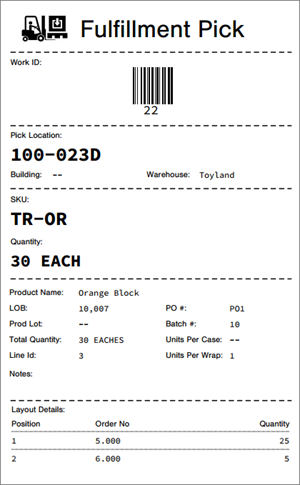Learn about the pros and cons of the different picking methodologies you can use in your warehouse to efficiently pick, pack, and ship orders.
Picking consists of gathering a specific quantity of items from warehouse locations to satisfy orders. In Infoplus, you select rules for the pick work. Here's an example of rule selections.

- The Picking Rule assigns an overall method for picking items (e.g. Simple Wave).
- The Pick Sort Rule assigns an order to pick items (e.g. by Location or SKU).
- The Layout Rule tells pickers where to put the items once picked (e.g., organize by Order or SKU).
- The Pick Scan Scheme sets scanning requirements for picking items (e.g., must scan the items' barcode, location, or both)
PICK WORK
When pick work is created, Pick Work Tickets indicate how to pick items based on the selected rules. Here is a sample pick ticket:

This ticket tells the picker to pick 30 of the TR-OR SKU (Orange Block) from location 100-023D.
The Layout Details at the bottom indicate to put 25 of the item in position 1, and 5 of the item in position 2. These decisions were based on the Layout rule selection.
Pick Work also considers Allocation Rules. For example, if an item to be picked has a “Strict FIFO” Allocation Rule (meaning always allocate from the oldest available PO lot first), the Work Ticket will indicate which location represents the oldest PO lot of the item.
Let's go into more detail about each of the Pick Work Rules.
PICKING RULES
Infoplus supports the following Picking Rules:
- Simple Wave
- Simple Wave with Casebreak
Simple Wave
When picking items in your warehouse using the Simple Wave picking method, all items needed for a process are picked at one time. You make one pass (or wave) through the warehouse to collect all items needed to fulfill the order(s) in your process. Items are then taken to a packing area where they are sorted and packed into their individual orders for shipping. This type of picking may also be referred to as typical pick/pack operations.
Simple Wave with Casebreak
When picking items in your warehouse using the Simple Wave with Casebreak method, all items needed for a process are picked at one time (just like the “Simple Wave” method); however, by adding Casebreak, any qualifying full case items needed for orders can be picked as a case, have the shipping label applied at the time of picking, and can then be brought straight to Shipping, bypassing the sorting and packing processes. During fulfillment, you have the option to enable auto-ship on casebreak cartons, which simply changes the Order's status to Shipped in Infoplus once the Fulfillment Process runs.
For items to be eligible for “casebreak” picking, they must meet BOTH of the following requirements:
- The “Casebreak-enabled” field on the Item record must be set to Yes.
- Any Item Receipts (created when items are received into the warehouse) must indicate Units Per Case, Case Weight, and Dimensions (Length, Width, Height).
NOTE: If an Order for a casebreak-enabled item does not fit the “Units per Case” increments as indicated in the Item record (e.g. 25 units per case), the outstanding items will be picked as eaches and will follow typical pick/pack operations. For example, if a casebreak-enabled item indicates there are 25 units per case, and there is an order for 30 of the item, one case can be picked as a casebreak pick, but the remaining 5 will need to be picked as eaches and follow the typical pick/pack operations.
Once items are picked, they are sorted and laid out based on the “Pick Sort Rule” and “Layout Rule.”
PICK SORT RULES
The Pick Sort Rule specifies whether to pick items for the selected orders by Location or SKU. The Pick Sort Rule impacts the sequence of Pick Work.
- If you sort Pick Work By Location, work will be organized in the most efficient manner considering the locations of items to be picked.
- If sorting Pick Work By Location, an additional Location Sort can be applied. By default, if using a Pick Sort Rule of Location, locations are sorted by location addresses. Alternatively, custom location sorts can be applied to sort locations however you choose. Please contact Infoplus Support for assistance with setting up a custom Location Sort.
- If you sort Pick Work By SKU, work will be organized by SKU.
LAYOUT RULES
The Layout Rule specifies how items will be laid out once they are picked.
- Layout by SKU will stage items for all orders by SKU. Items will be placed together into positions and then pulled for packing into the appropriate carton(s) for each order.
- Layout by Order will stage items by order. Items will be placed with other items in the order. The entire order can then be packed into the appropriate carton(s) from each position.
The Layout position for each item will be indicated on the Pick Work ticket.
PICK SCAN SCHEME
A Pick Scan Scheme is a set of scanning requirements for picking items to fulfill orders. You can require scanning the Item's barcode, or the Item's location, neither, or both. You can specify different scanning requirements for loose picks and casebreak picks.
A Default Pick Scan Scheme will be available in Infoplus which requires the Location be scanned when picking, but not the Item. If you have other scanning requirements, you can edit the Default or create your own schemes.
FULFILLMENT PLANS
Be aware that you can preset Pick Work rules, and other options, with a Fulfillment Plan. Use a Fulfillment Plan to streamline the process of fulfilling orders. See Create a Fulfillment Plan for more information.

-1.png?height=120&name=InfoPlus-Primary-Logo%20(1)-1.png)